Lincolnshire garden tour 5-8 June 2014

Lincoln cathedral
Our visit was based at the Lincoln Hotel directly opposite the cathedral in the centre of Lincoln. Soon after our arrival Jo Bennison gave us a talk on the genus Paeonia, Peonies: where species grow in the wild. Jo took us through a selection of wild species including the distinctly feathery leaved P. tenuifolia and P.mlokosewitchii which is in constant demand for its distinct soft yellow flowers, but she pointed out that only some of the wild populations have yellow flowers and others are pink or even white.
The majority of the species are early flowering but the later flowering P. lactiflora, and more importantly its hybrids, provide us with the majority of the herbaceous peonies in our gardens. She talked about the tree peonies and how they are becoming increasingly rare in China due to over collecting, particularly for traditional herbal remedies. And finished with the relatively recent intersectional or Itoh hybrids – these are hybrids between the tree peonies and the herbaceous. In garden terms they are excellent and reliable plants with quite short woody growths and wonderful flowers.
On Friday 6 June, a beautiful and sunny warm day, our first garden was at Mill Farm, Grasby (www.millfarmgarden.co.uk), where Helen Boothman and husband Mike greeted us. Set in 3½ acres, this garden is less than 10 years old and has wonderful views over the north Lincolnshire countryside. The garden has a range of elements and we first passed the wildlife pond guarded by a larger than life sized heron. Rich red lupins filled a bed around a sundial by the house, strikingly accompanied by a Digitalis ‘Illumination Pink’ which had struggled through the mild winter but recovered and was in full flower. A rill set in a gravel feature was edged with a Sedum, not in flower but with a colour that matched the slate monolith at the head of the rill. The new slatted shade house had just been completed and was obviously a future haven for a green luxuriant space.
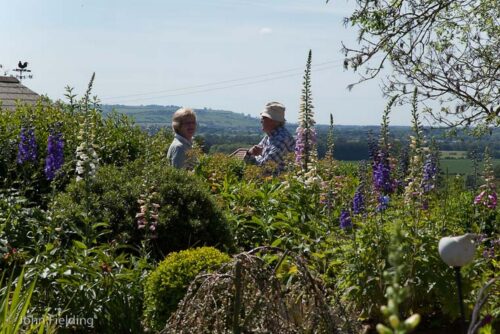
Mill Farm, Helen Boothman talking with John Wayland
On from here you enter a rose garden with a cross path separating four rose beds intermingled with various herbaceous plants including peonies. Subtle yellows are a feature of the planting around the summerhouse, and Linaria dalmatica is particularly interesting, a tall grey-leaved species. A wide range of herbaceous perennials is planted throughout. On the far side of the garden the remains of a windmill houses a collection of shade-loving ferns and likeminded plants, all protected from the wind as well as the sun.
Tea, coffee and delicious home made cakes, and scones (this is what I had), finished our visit!
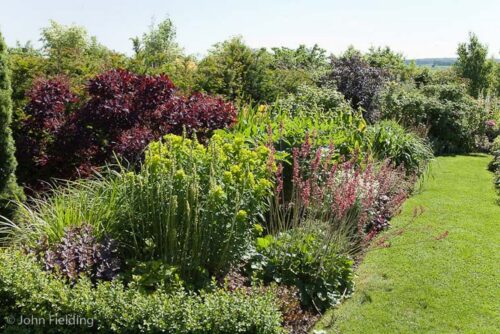
Mill Farm, herbaceous border
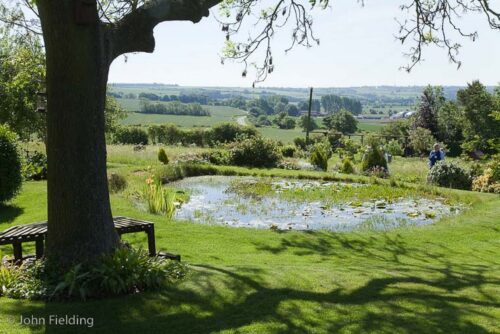
Mill Farm, wildlife pond
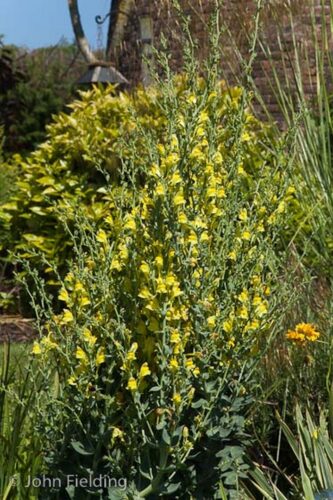
Mill Farm, Linaria dalmatica
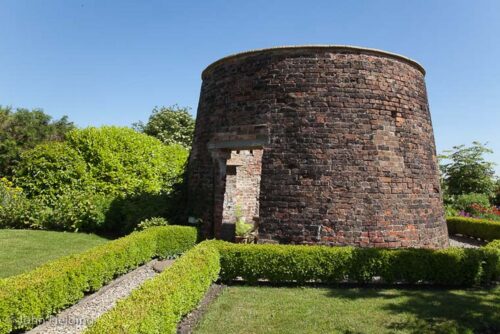
Mill Farm, base of windmill
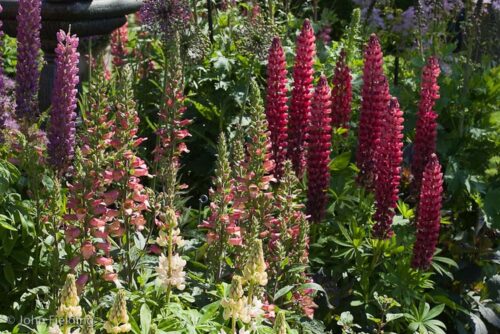
Mill Farm, Digitalis ‘Illumination Pink’ with Lupins
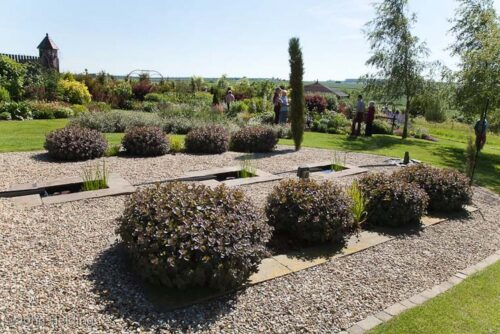
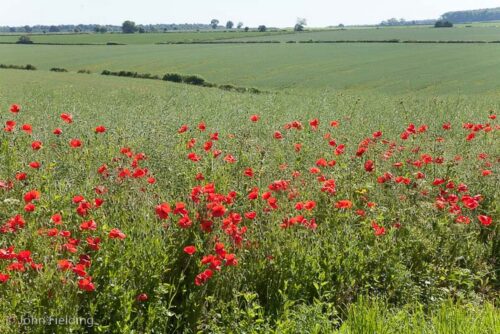
Mill Farm, view from garden with poppies
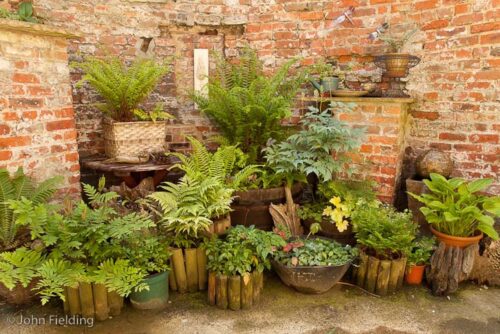
Mill Farm, ferns in base of windmill
Pottertons Garden and Nursery (http://www.pottertons.co.uk/) was our next stop where Rob and Jackie Potterton run the alpine and woodland nursery started by Rob’s parents, Bob and Jean Potterton, with Alan Martin. Rob took us on a tour of the nursery. Different areas under polythene tunnels house alpines, dwarf bulbs and woodland plants, and mostly have side venting to let air through. One propagation tunnel was not vented so as to provide high humidity for cuttings. Raised beds provide long-term nurseries for gems such as Trillium which can take 10 years or more to mature from seed. Our tour finished in the garden dominated by a large beautifully planted rockery and pond. The plants flowering and most prominent included lovely clumps of Dianthus that were about 10 years old and on enquiring what species they were Rob had to ask Jackie as we couldn’t locate the label. The answer was Dianthus spiculifolius, a variety I hadn’t come across before. The visit ended with a search through their extensive sales area with a number of us not leaving empty handed.
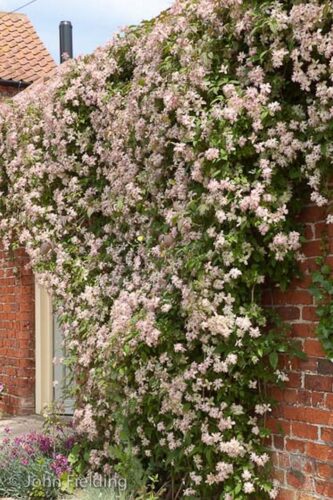
Goltho House, Clematis montana ‘Marjorie’
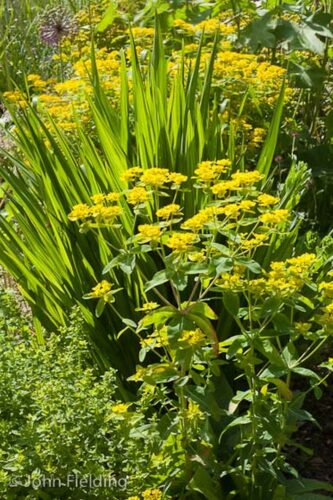
Goltho House, Euphorbia hyberna
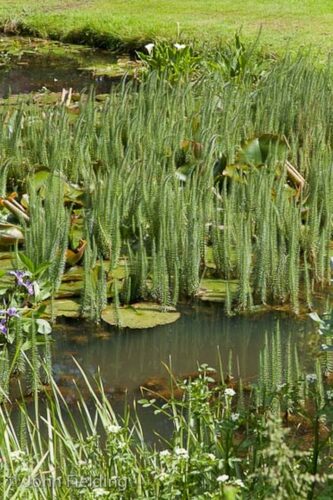
Goltho House, pond with Hippurus vulgaris
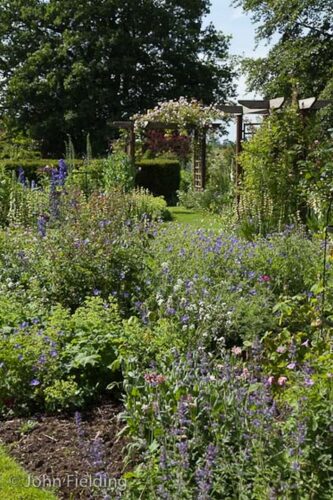
Goltho House
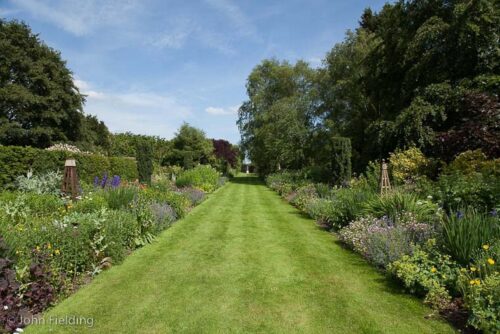
Goltho House
Lunch was at our third garden, Goltho House, Wragby (www.golthogardens.com). Debbie Hollingworth greeted us along with a few other visitors as the garden is open to the public from February to December. This is another young garden of 4½ acres and less than 10 years old. As you enter from the car park the tearooms on your left face a lovely dry garden next to the plant sales area. A fine specimen of Clematis Montana ‘Marjory’ with its distinctive double flowers covered much of a pretty brick wall. Carpentaria californica was in full flower with its pristine white clusters. Euphorbia was scattered and I assume self-seeded throughout. Debbie couldn’t put a name to it but I think it was E. hyberna an attractive but quite weedy species. Dominating this was a single impressive specimen, possibly E. cornigera or at least a species in that group.
From this area you walk through to the potager managed to provide food: ornamental as well as practical. Moving on you arrive at a couple of ponds where the lawn reaches the water’s edge; otherwise the ponds are surrounded by lush planting and a weeping willow tree. Walks continue through various wooded areas include spring and autumn plantings which we obviously couldn’t appreciate on this visit. The central part of the garden is a long lawn vista (the owners call it their ‘runway’) from the house almost to the end of the garden, with dense herbaceous borders on either side, and adjacent is a small wildflower meadow and a prairie garden. Goltho House also offers a couple of B&B period rooms.
Our last garden of this warm and pleasant day was Overbeck, Scothern, home to John and Joyce Good who open their garden for the NGS scheme and cancer charities. This garden was packed with wonderful plants, all immaculately grown. The spacious front garden has borders around a lawn and at the very front we enjoyed a lovely combination of Lilium pyrenaicum with an array of blues from Polemonium, Delphinium, Nigella and Borago.
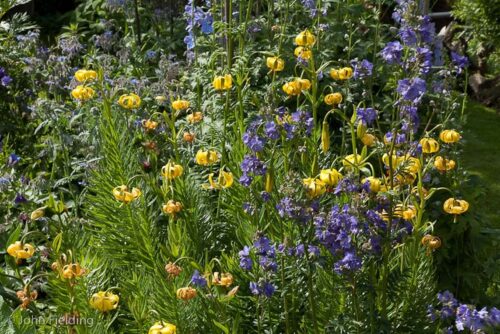
Overbeck, Lilium pyrenaicum
En route to the back garden is an impressive collection of Hosta in a bed of its own, and without a single blemish! I was drawn to the pond where a pot of the miniature bulrush Typha minima was in full flower. In a shady arbor behind the pond is a collection of ferns including the Oak Fern, Gymnocarpium dryopteris. A mixed border with many choice plants still to flower had clouds of Thalictrum aquilegifolium. Further up the slope a white border was in full swing, floristically, and dominated by Silene fimbriata. At the end of the garden a substantial vegetable plot was as immaculate as the rest of the garden and looked wonderfully productive. A strong element of this garden is for cutting as Joyce is a member of Lincoln cathedral’s flower rota.
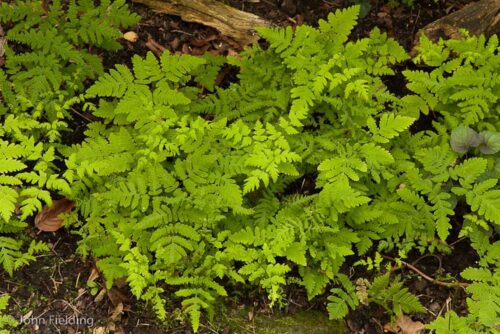
Overbeck, Gymnocarpium dryopteris
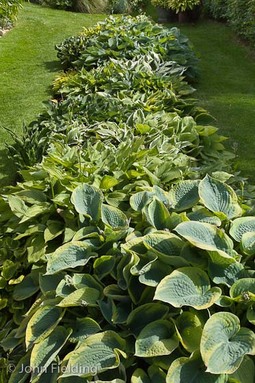
Overbeck, Hosta bed
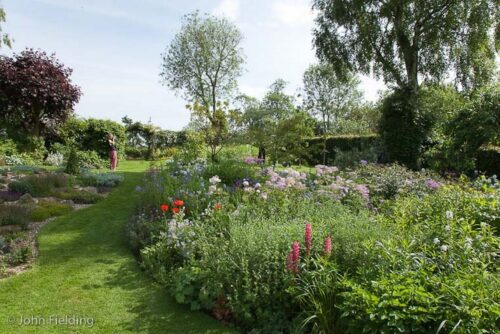
Overbeck, Thalictrum aquilegifolium in herbaceous border
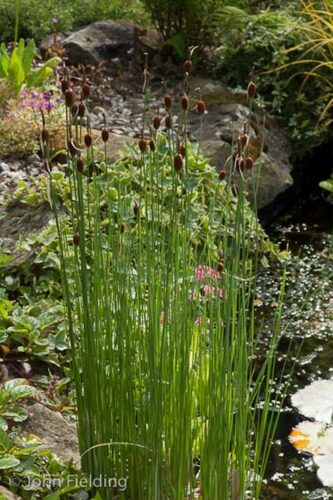
Overbeck, Typha minima
Back to the hotel and a talk before our meal from Joan Head on lavenders. Joan had had a national collection and was particularly interested in the species. She has spent years researching them and liaising with professional botanists. She has also travelled extensively to see species in the wild and gave us an insight into not only the well known species but obscure and extremely localised ones too. The genus is spread across both sides of the Mediterranean basin and down into the Sahara and Macaronesia (including islands of the Azores, Madeira, Canary and Cape Verde) through the Middle East where some species are extremely localised, and on into India where there are another two species. She also talked about lavender oil production and how it has spread to climes such as Tasmania.
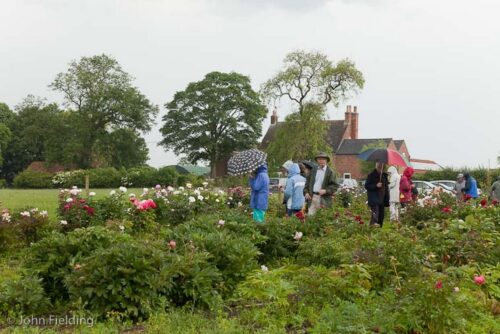
Bennison Peonies
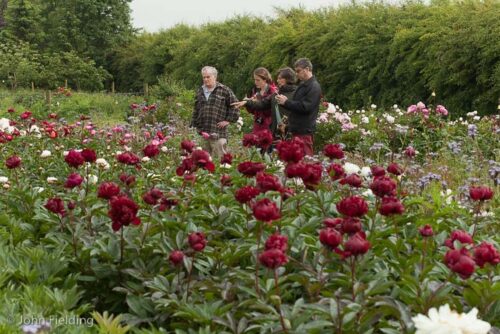
Bennison Peonies, Paeonia ‘Chippewa’ with Jo Bennison
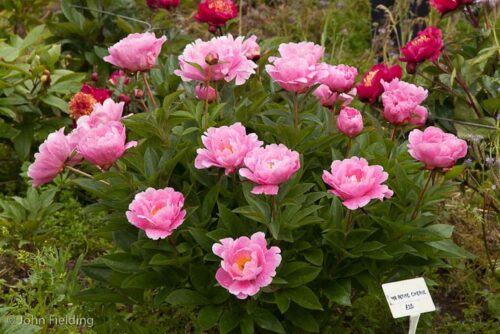
Bennison Peonies, Paeonia ‘Ma Petite Cherie’
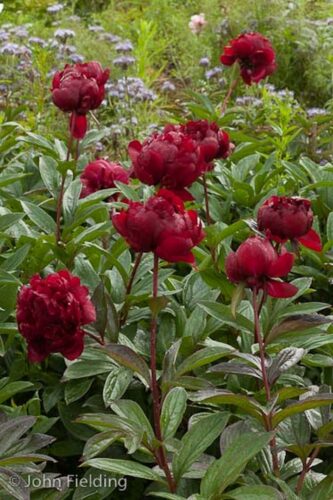
Bennison Peonies, Paeonia ‘Chippewa’
We started Saturday 7 June with an absolutely horrendous weather forecast. Torrential rain was due with frequent lightning. But perhaps we would get a dry start! Well, it was quite dry with just a few spots of rain. We arrived at Bennison Peonies, East Firsby (www.bennisonpeonies.co.uk) after the first shower was over. Jo Bennison led us into the field of stock plants growing among drifts of Phacelia tanacetifolia, often grown as a green manure crop. The weather stayed virtually dry and we saw her late flowering peonies and Itoh hybrids, many in full flower. I will mention two that stood out to me as having well survived whatever the weather had thrown at them. Paeonia ‘Ma Petit Sue’ is of moderate height with semi-double bold pink flowers. The flowers are held quite close to the foliage but maintained a very nice shape. Paeonia ‘Chippewa’ is an outstanding dark red – perhaps helped by the fact that there was a large quantity of it but it really stood up with the sultry flowers held well above the dark foliage: superb. Sadly on just reading Jo’s blog I see she had to cancel her last open weekend (14 – 15 June) due to really bad weather of too much rain, hail and then buffeting hot winds.
From there, on to the Garden House, Saxby (www.thegardenhousesaxby.co.uk) where Chris Neave met us and we quickly imbibed in the Hay Barn tearoom, concerned about how soon the threatened tempest would arrive. Chris gave us an introductory talk about the extensive garden – but happily still no rain.
We set off around the garden where I have to admit that I accepted the offer to wander to photograph whilst the rest were taken on a tour. I was quite content snapping away at the wonderful range of plants and various garden areas. In two places Penstemon ‘Pensham Czar’ created a bold feature covered in so many flowers that you couldn’t see the plant beneath. Kniphofia hirsuta was perfect, it is a relatively new compact and considerably hardy species to cultivation from the high Drakensberg. Dictamnus albus was at its best in two adjacent clumps in its pink and white forms. I also liked the easy to lose Campanula ‘Chettle Charm’ with large white flowers edged in pale blue – perhaps because its seedling don’t come true and it is over taken by them. But by now the rain was pouring down and after a while of photographing from under an umbrella I gave up. We sheltered and Chris’s partner Jonathon Cartwright plied us with more tea whilst explaining that his input was more on the maintenance side, which we all know is of no little importance. Lunch was at the farm café Uncle Henry’s that also sells a wide range of local produce (including famous Lincoln sausages) and foods from further afield including specialist Welsh cheeses.
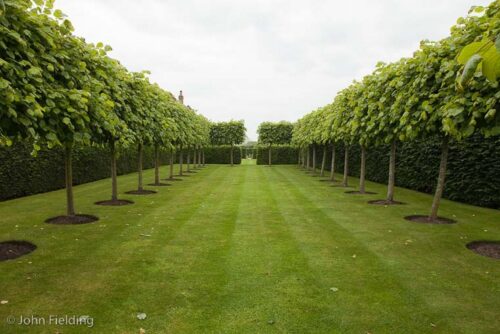
The Garden House
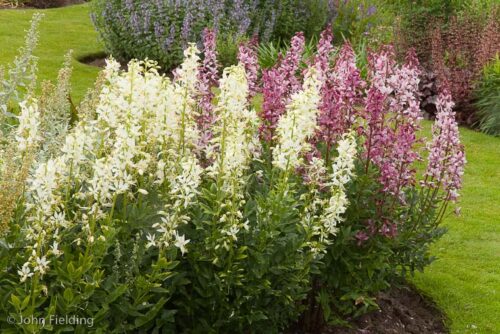
The Garden House, Dictamnus albus
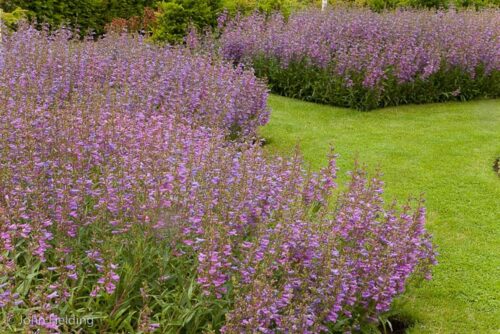
The Garden House, Penstemon ‘Pensham Czar’
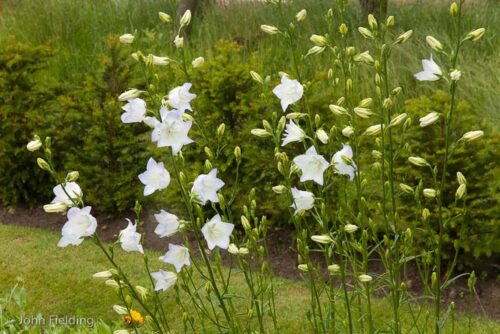
The Garden House, Campanula persicaria ‘Chettle Charm’
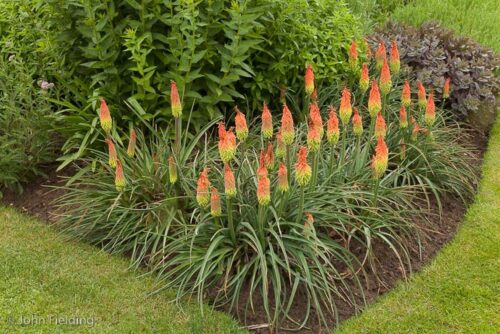
The Garden House, Kniphofia hirsuta
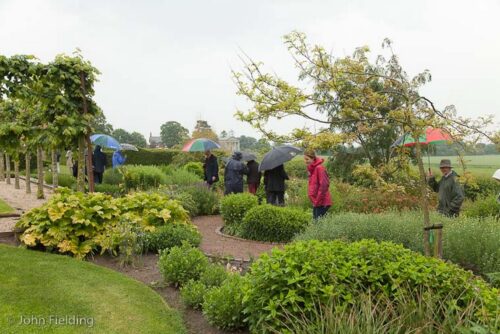
The Garden House, rain stopped play
Our last visit was Hall Farm, Gainsborough (www.hall-farm.co.uk) owned by Pam and Mark Tatam. Once again the rain held off and we arrived to brightening skies and a blaze of Nepeta ‘Six Hill’s Giant’ in a formal square where the sales area of their nursery used to be. Adjacent to this is a box parterre filled with herbs, one of which is a familiar giant from the Mediterranean, Ferula communis in full flower and taller than any of us.
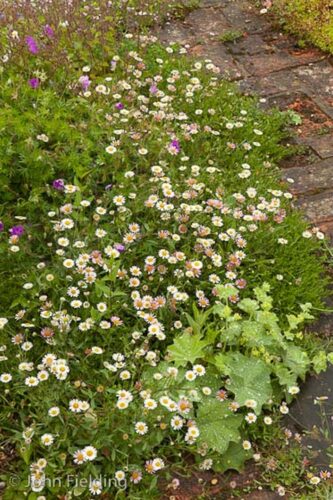
Hall Farm, Erigeron karvinskianus
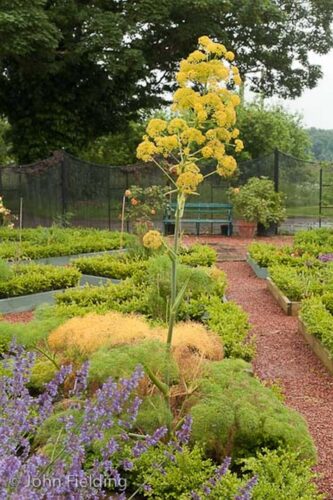
Hall Farm, Ferula communis
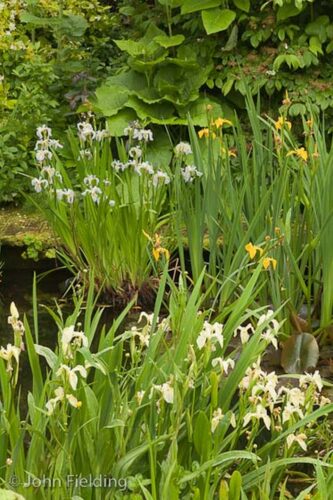
Hall Farm, Iris in pond
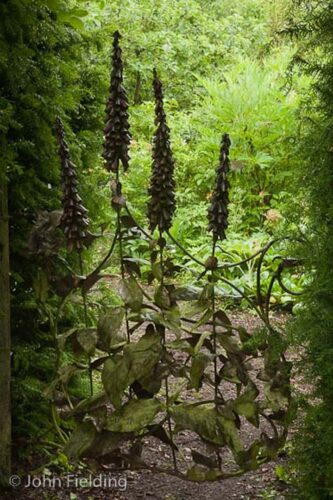
Hall Farm, foxglove gate
An extra pleasure was various sculptural elements including obelisks, a gate of metal foxgloves, and cut out dancing figures in a meadow. One “room” is a chessboard with simplified welded chess pieces. Sadly the rain crept in on us and soon it was constant so we retired to the house for tea and shelter. This garden is open throughout the summer and later in support of various charities – we could see extensive planting for autumn borders in front of the house. Sadly we did not have time to explore the furniture making, forge and sculpture workshops houses in outbuildings here too.
I would also like to emphasise that the warmth and friendliness with which we were greeted at every venue was wonderful; a big thank you to all of you who hosted us in your gardens. And, a special thank you to Sue Bennison who yet again has come up with a totally successful programme for us. Thank you Sue.
There is further information on the various websites, and see RHS The Garden May 2014 for a detailed article on Bennison Peonies.
John Fielding

